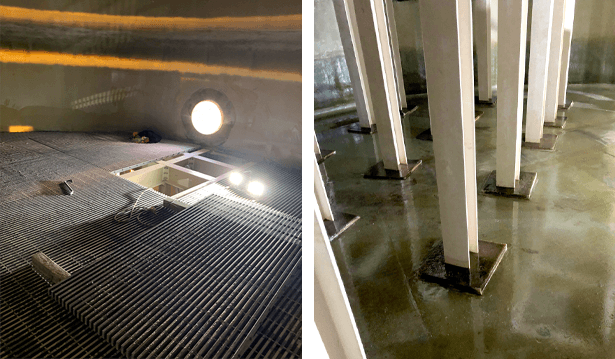Case Study: H2S Scrubber Tank Support Structure


In many instances, hydrogen sulfide gas is produced as a byproduct of water treatment or raw material manufacturing processes.
If left untreated, the corrosive gas can be detrimental. Most facilities use scrubbers to neutralize the harmful gas prior to atmospheric release.
This is why a pulp processing company wanted to install a new H2S vertical packed bed scrubber measuring 26' in diameter and 55' in height at one of their facilities in Alberta, Canada. In operation since the late 1980s, the pulp mill has been capturing and converting captured biogases for onsite renewable electricity usage. As a way to filter and capture some of these gases for renewable electricity, this type of scrubber uses air pressure and water to recirculate the captured gases into the compacted bedding system for further processing within an operational temperature range of -40°C to +40°C.
The end user hired Structural Composite Technologies (SCT) located in Winnipeg, Manitoba, for their 60+ years of experience designing, fabricating, and assembling industrial designs within the mining, milling, smelting, refining, and manufacturing sectors.
| TECHNICAL DATA |
|---|
| Product: H2S Scrubber Tank Support Structure |
| Process: Pultrusion, Fabrication |
Materials & Sizes:
|
| For: Structural Composite Technology (Winnipeg, MB) |
| User: Millar Western Forest Products (Whitecourt, AB) |
For this particular scrubber tank support application, SCT needed to ensure long-term structural integrity coupled with exceptional corrosion resistance. EXTREN® Series 625 wide flange and I-beams were used to support 2" DURAGRID® HD-6000 pultruded grating with 6" cross-rod spacing. Combined together, these two products hold all of the packing material within the scrubber. As an added measure to prevent chemical attack, the components were mechanically fastened with Hastelloy instead of 316L grade stainless steel.
Strongwell worked with SCT in designing, fabricating, and piece marking the platform’s components to ensure that the sections would be dropped into place without further fabrication upon delivery.
At the conclusion of this project, SCT and other involved companies were complimentary of the overall supply, delivery, and design experience of the scrubber’s internal FRP platform.